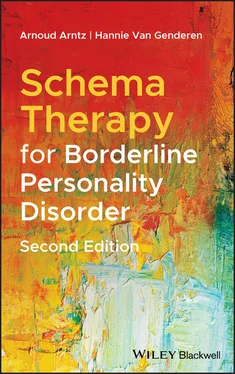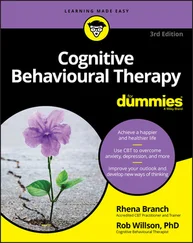Hannie van Genderen - Schema Therapy for Borderline Personality Disorder
Здесь есть возможность читать онлайн «Hannie van Genderen - Schema Therapy for Borderline Personality Disorder» — ознакомительный отрывок электронной книги совершенно бесплатно, а после прочтения отрывка купить полную версию. В некоторых случаях можно слушать аудио, скачать через торрент в формате fb2 и присутствует краткое содержание. Жанр: unrecognised, на английском языке. Описание произведения, (предисловие) а так же отзывы посетителей доступны на портале библиотеки ЛибКат.
- Название:Schema Therapy for Borderline Personality Disorder
- Автор:
- Жанр:
- Год:неизвестен
- ISBN:нет данных
- Рейтинг книги:3 / 5. Голосов: 1
-
Избранное:Добавить в избранное
- Отзывы:
-
Ваша оценка:
- 60
- 1
- 2
- 3
- 4
- 5
Schema Therapy for Borderline Personality Disorder: краткое содержание, описание и аннотация
Предлагаем к чтению аннотацию, описание, краткое содержание или предисловие (зависит от того, что написал сам автор книги «Schema Therapy for Borderline Personality Disorder»). Если вы не нашли необходимую информацию о книге — напишите в комментариях, мы постараемся отыскать её.
Shema Therapy for Borderline Personality Disorder
Schema Therapy for Borderline Personality Disorder
Schema Therapy for Borderline Personality Disorder — читать онлайн ознакомительный отрывок
Ниже представлен текст книги, разбитый по страницам. Система сохранения места последней прочитанной страницы, позволяет с удобством читать онлайн бесплатно книгу «Schema Therapy for Borderline Personality Disorder», без необходимости каждый раз заново искать на чём Вы остановились. Поставьте закладку, и сможете в любой момент перейти на страницу, на которой закончили чтение.
Интервал:
Закладка:
These traumatic experiences in combination with temperament, insecure attachment, developmental stage of the child, as well as the social situation in which things took place, result in the development of dysfunctional interpretations of the patient's self and others (Arntz, Weertman, & Salet, 2011; Zanarini, 2000). Patients with BPD have a disorganized attachment style. This is the result of the unsolvable situation they experienced as a child, in which their parent was both a menace or threat, as well as a potential safe haven (van IJzendoorn, Schuengel, & Bakermans‐Kranenburg, 1999). Translated into cognitive terms, a combination of dysfunctional schemas and coping strategies results in BPD (e.g., Arntz et al., 2011).
Patients with BPD have a very serious and complex set of problems. Because the patient's behavior is so unpredictable, it exhausts the sympathy and endurance of family and friends. Life is not only difficult for the patients, but also for those around them. At times, life is so difficult that the patient gives up (suicide) or her support system gives up and breaks off contact with the patient. Treating BPD patients is often also fatiguing for the mental health care giver, especially in the absence of effective treatment methods. The good news is that effective treatments have been developed the last decades, and schema therapy is one of the most successful.
Schema therapy offers BPD patients and therapists a treatment model in which the patient is helped to break through the dysfunctional patterns she has created and to achieve a healthier life. The model helps patients and therapists to understand how early childhood experiences are related to the present problems and offers grip on the otherwise overwhelming and difficult to understand problems. Treating BPD patients with schema therapy makes it relatively easy to comprehend the patient's dysfunctional behavior and it gives the therapist many tools to treat the patient.
2 Schema Therapy for Borderline Personality Disorder
The Development of Schema Therapy for Borderline Personality Disorder
Before the development of specialized psychotherapies for BPD, such as schema therapy (ST), BPD was treated primarily from a psychoanalytical perspective. This started to change in the late 1980s when cognitive behaviorists began to study the treatment of personality disorders with cognitive behavioral therapy, and psychodynamic therapists started to develop variants of psychodynamic therapy that were specifically adapted to BPD.
The most important early developments in specialized psychotherapies for BPD that emerged in this era were the formulation and empirical validation of Dialectical Behavior Therapy (DBT; Linehan, Armstrong, Suarez, Allmon, & Heard, 1991; Linehan, 1993), the development of Transference‐Focused Psychotherapy (TFP) (Kernberg, Selzer, Koenigsberg, Carr, & Applebaum, 1989), the development of Mentalization Based Treatment (MBT, Bateman & Fonagy, 2004), and the development of cognitive therapy for personality disorders. The use of cognitive therapy for treating personality disorders was first introduced by Aaron Beck, Arthur Freeman, and colleagues in their work Cognitive Therapy of Personality Disorders (1990). In that same year, Jeffrey Young introduced a new form of cognitive therapy, which he referred to as “Schema‐Focused Therapy,” later “Schema Therapy” (Young, 1990, 1994). He later expanded upon this therapeutic model with the introduction of schema modes (Young, Klosko, & Weishaar, 2003). His theory is based upon a combination of insights derived from cognitive, behavioral, psychodynamic, humanistic, and developmental (including attachment) theories. The actual treatment is mainly based on cognitive behavioral therapy and techniques derived from experiential therapies. There is a strong emphasis on the therapeutic relationship which is used as a means to bring about change, as well as on the emotional processing of traumatic experiences.
To date, ST appears to be a good method to achieve substantial personality improvements in BPD patients.
Research Results
Research on traditional psychoanalytical forms of treatment showed high dropout percentages (46–67%) and a relatively high percentage of suicide. Across four longitudinal studies, approximately 10% of the patients died during treatment or within 15 years following treatment due to suicide (Paris, 1993). This percentage is comparable to that of nonpsychotherapeutically treated BPD patients (8–9%: as reported by Adams, Bernat, & Luscher, 2001).
The first controlled study of cognitive behavioral treatment for BPD was realized by Linehan et al. (1991). The DBT they introduced had lower dropout rates, fewer hospitalizations, and a greater reduction in self‐injury and suicidal behavior in comparison with usual treatment. On other measurements of psychopathology, there were no significant differences when compared with usual treatment. Uncontrolled studies as to the effectiveness of Beck's cognitive therapy also showed a reduction in suicide risk and depressive symptoms, as well as a decrease in the number of BPD symptoms (Arntz, 1999; Beck, 2002; Brown, Newman, Charlesworth, Crits‐Christoph, & Beck, 2004). Moreover, the dropout rates during the first year were lower than normal (about 9%).
The first controlled study testing ST as developed by Young was conducted in the Netherlands, where ST was compared to TFP, a psychodynamic method from Kernberg and co‐workers (Giesen‐Bloo et al., 2006). This study started in 2000 and involved 3 years of treatment. ST showed more positive results than TFP in reduction of BPD symptoms, as well as other aspects of psychopathology and quality of life. In the follow‐up study, 4 years after the start of the treatment, 52% of the patients who started ST recovered from BPD, compared to 29% in TFP, while more than two‐thirds of ST participants showed clinically significant improvement in reducing BPD symptoms, compared to 52% in TFP. These percentages are impressive given that dropouts (even those due to somatic illness) were included in the study.
One of the most compelling results from this first randomized clinical trial (RCT) was that all BPD problems were reduced and not only conspicuous symptoms such as self‐harm. For instance, the patient's quality of life as a whole and her feeling of self‐esteem improved significantly. Thus, as a result of ST, all psychopathological characteristics of BPD, whether symptomatic or personality related, significantly improved. Similar results were found in a Norwegian series of case studies. When patients were measured post‐treatment, 50% no longer met the criteria for BPD and 80% appeared to have notably profited from the treatment (Nordahl & Nysæter, 2005).
Despite the high treatment costs, this first RCT on ST also demonstrated that ST is cost‐effective, as evidenced by a cost‐effectiveness analysis showing that ST is not only superior to TFP in effects, but also less costly. Moreover, compared with baseline, ST leads to a reduction of societal costs for BPD patients, so that the net effect was a reduction of costs, despite the costs involved in delivery of ST (van Asselt et al., 2008).
The question whether ST has similar effects when implemented in clinical practice was addressed in a study by Nadort et al. (2009). Results indicated that effectiveness and treatment retention were similar to those of the Giesen‐Bloo et al. (2006) trial. The study also addressed the issue whether therapists should provide a phone number that patients could use when in crisis outside office hours, as was originally prescribed by the protocol. As the results did not yield any evidence for a positive effect of this, providing such a phone contactability was deleted from the protocol. As will be seen, giving patients an email address that they can use to share experiences with their therapist outside office hours, without any obligation of therapists to respond immediately, has replaced the phone contactability.
Читать дальшеИнтервал:
Закладка:
Похожие книги на «Schema Therapy for Borderline Personality Disorder»
Представляем Вашему вниманию похожие книги на «Schema Therapy for Borderline Personality Disorder» списком для выбора. Мы отобрали схожую по названию и смыслу литературу в надежде предоставить читателям больше вариантов отыскать новые, интересные, ещё непрочитанные произведения.
Обсуждение, отзывы о книге «Schema Therapy for Borderline Personality Disorder» и просто собственные мнения читателей. Оставьте ваши комментарии, напишите, что Вы думаете о произведении, его смысле или главных героях. Укажите что конкретно понравилось, а что нет, и почему Вы так считаете.












